You can’t come to Madison and NOT see at least SOME of the things that makes this one of the best small cities in the Midwest! Although we are NOT suggesting you skip out of the conference to tour the city and surrounding areas, if you have some free time here are our suggestions for the best things to see and do in and around Madison. Better yet, extend your time before and/or after the conference to take in even more of what we have to offer!
Within Walking Distance (<2 miles)
State Street
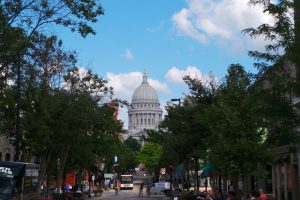 No trip to Madison is complete without a walk up State Street from Library Mall on the UW campus to the Capitol (just a block over from the Pyle Center). Mostly a pedestrian mall (but buses, bicycles and delivery and emergency vehicles are allowed), it has a funky variety of locally owned, unique shops, bars, and restaurants as well as street musicians, jugglers and other types of buskers along the half mile length. Wide sidewalks accommodate outdoor cafe and restaurant seating at many places.
No trip to Madison is complete without a walk up State Street from Library Mall on the UW campus to the Capitol (just a block over from the Pyle Center). Mostly a pedestrian mall (but buses, bicycles and delivery and emergency vehicles are allowed), it has a funky variety of locally owned, unique shops, bars, and restaurants as well as street musicians, jugglers and other types of buskers along the half mile length. Wide sidewalks accommodate outdoor cafe and restaurant seating at many places.
Wisconsin State Capitol & Capitol Square
 Standing over 200 feet tall at the end of State Street on an isthmus between two lakes, Lake Monona and Lake Mendota, the Capitol is the tallest building in Madison (legislation passed in 1990 prohibits buildings within a mile from being taller than the columns surrounding the dome =187 feet). Completed in 1917, this architectural masterpiece is made of 43 types of stone from around the world; the exterior stone is Bethel white granite from Vermont, making it the largest granite dome in the world. It is topped by the gilded bronze statue, “Wisconsin” by Daniel Chester French (nor “Forward,” the state motto, which it is commonly misidentified as). The building was designated a National Historic Landmark in 2001.
Standing over 200 feet tall at the end of State Street on an isthmus between two lakes, Lake Monona and Lake Mendota, the Capitol is the tallest building in Madison (legislation passed in 1990 prohibits buildings within a mile from being taller than the columns surrounding the dome =187 feet). Completed in 1917, this architectural masterpiece is made of 43 types of stone from around the world; the exterior stone is Bethel white granite from Vermont, making it the largest granite dome in the world. It is topped by the gilded bronze statue, “Wisconsin” by Daniel Chester French (nor “Forward,” the state motto, which it is commonly misidentified as). The building was designated a National Historic Landmark in 2001.
 There is no main entrance, but many entrances on all sides. Inside you’ll find dark corridors that lead to the dramatic rotunda, which is flooded with natural light from the windows below the dome. The Italian-styled Governor’s conference room is adorned with 26 historical and allegorical paintings by Hugo Ballin and French walnut furniture, while the Senate and Assembly Chambers feature New York and Italian marble and a magnificent Edwin Blashfield mural. Open to the public, experience the beauty and grandeur of the place through a free guided tour (several times daily) or explore on your own. Check out the observation deck for 360 degree views of the surrounding area!
There is no main entrance, but many entrances on all sides. Inside you’ll find dark corridors that lead to the dramatic rotunda, which is flooded with natural light from the windows below the dome. The Italian-styled Governor’s conference room is adorned with 26 historical and allegorical paintings by Hugo Ballin and French walnut furniture, while the Senate and Assembly Chambers feature New York and Italian marble and a magnificent Edwin Blashfield mural. Open to the public, experience the beauty and grandeur of the place through a free guided tour (several times daily) or explore on your own. Check out the observation deck for 360 degree views of the surrounding area!
Website: https://capitol100th.wisconsin.gov/
Address: 2 E Main St, Madison
Phone: 608-266-0382
 The four streets surrounding the building form the Capitol Square, which is home to many restaurants and shops. If you’re into cheese, Fromagination, is a great destination at 3309 12 S Carroll St on the west side of the Square. Some of the other noteworthy restaurants on the Square include L’Etoile, Graze, Merchant, and The Old Fashioned, with many others on the side streets radiating out from the capitol.
The four streets surrounding the building form the Capitol Square, which is home to many restaurants and shops. If you’re into cheese, Fromagination, is a great destination at 3309 12 S Carroll St on the west side of the Square. Some of the other noteworthy restaurants on the Square include L’Etoile, Graze, Merchant, and The Old Fashioned, with many others on the side streets radiating out from the capitol.
 On Saturdays from 6:15 am to 1:45 pm, the tree-lined sidewalks around the Capitol are transformed into the Dane County Farmer’s Market, the country’s largest producer-only Farmers’ Market in the country featuring Wisconsin agricultural products direct from over 275 vendors. Offering a great selection of in-season local produce, flowers, plants, baked goods, fantastic artisanal cheese and fresh cheese curds (many vendors offer samples!), popcorn and many other items. Even if you don’t want any vegetables while traveling, it’s a great experience and a fun place to pick up some homemade jams & jellies, honey, real Wisconsin maple syrup, cheese or baked treats to take back to family or colleagues who couldn’t make the conference. Just make sure you go with the flow of the crowd and walk counter-clockwise around the square! There is a smaller Wednesday Market from 8:30 am to 1:45 pm just south of the Square on the 200 block of Martin Luther King Jr. Blvd, in between the Madison Municipal Building and the City County Building, on the street that goes from the Capitol to Monona Terrace.
On Saturdays from 6:15 am to 1:45 pm, the tree-lined sidewalks around the Capitol are transformed into the Dane County Farmer’s Market, the country’s largest producer-only Farmers’ Market in the country featuring Wisconsin agricultural products direct from over 275 vendors. Offering a great selection of in-season local produce, flowers, plants, baked goods, fantastic artisanal cheese and fresh cheese curds (many vendors offer samples!), popcorn and many other items. Even if you don’t want any vegetables while traveling, it’s a great experience and a fun place to pick up some homemade jams & jellies, honey, real Wisconsin maple syrup, cheese or baked treats to take back to family or colleagues who couldn’t make the conference. Just make sure you go with the flow of the crowd and walk counter-clockwise around the square! There is a smaller Wednesday Market from 8:30 am to 1:45 pm just south of the Square on the 200 block of Martin Luther King Jr. Blvd, in between the Madison Municipal Building and the City County Building, on the street that goes from the Capitol to Monona Terrace.
Memorial Union
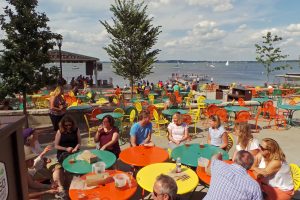 Just a few steps from the Pyle Center, on the other side of the newly opened 1.3-acre Alumni Park, this is one of the most beloved and historic destinations on UW-Madison’s campus. Set on the shore of Lake Mendota, the Memorial Union houses many activities in the historic building, but it’s the large outdoor Terrace filled with iconic bright green, orange and yellow sunburst chairs that is the popular spot among students and local residents for socializing in summer because of the backdrop of the lake, with its view of sailboats, and the sound of live music, usually free to the public in the evening. Inside the building you can find Der Rathskeller, a German-style beerhall with elaborate murals, The Daily Scoop selling Babcock ice cream (made at the University — see below) and the privately managed Peet’s Coffee Shop.
Just a few steps from the Pyle Center, on the other side of the newly opened 1.3-acre Alumni Park, this is one of the most beloved and historic destinations on UW-Madison’s campus. Set on the shore of Lake Mendota, the Memorial Union houses many activities in the historic building, but it’s the large outdoor Terrace filled with iconic bright green, orange and yellow sunburst chairs that is the popular spot among students and local residents for socializing in summer because of the backdrop of the lake, with its view of sailboats, and the sound of live music, usually free to the public in the evening. Inside the building you can find Der Rathskeller, a German-style beerhall with elaborate murals, The Daily Scoop selling Babcock ice cream (made at the University — see below) and the privately managed Peet’s Coffee Shop.
Website: https://union.wisc.edu/visit/memorial-union/
Address: 800 Langdon St., Madison
Phone: (608) 265-3000
Ride A Bike
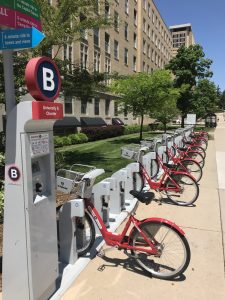
Don’t want to walk or drive everywhere? Madison is the unofficial bike capital of the Midwest and boasts more bikes than cars! Miles of well-maintained networks of paths and bike trails make this a fun and safe place to ride. With 40+ stations across the city, Madison BCycle, the city’s urban bike-sharing program, makes it convenient to get around Madison on a bike. A portion of the Capital City State Trail goes by Monona Terrace and crosses Lake Monona on a causeway with exceptional views of the State Capitol dome and connects with the Wingra Creek Bike Path that goes to Henry Vilas Zoo, beaches at Vilas Park, and, farther on, a shady ride through the University of Wisconsin–Madison Arboretum. You can also get to Olbrich Botanical Gardens going the other direction on this trail.
Website: https://madison.bcycle.com/
Allen Centennial Gardens
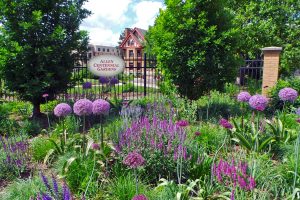 This hidden gem surrounded by dorms and tall educational buildings features 25 styles of gardens from around the world, from a formal French garden to rock garden with alpine plants on just 2.5 acres around the historic Victorian Gothic Agricultural Dean’s House (on the National Register of Historic Places and the home of the first four deans of the College of Agricultural and Life Sciences; once renovated it will become a new student center) on the west side of the UW-Madison campus. It is maintained as part of the Horticulture Department to serve as an outdoor classroom for students and others and is always evolving.
This hidden gem surrounded by dorms and tall educational buildings features 25 styles of gardens from around the world, from a formal French garden to rock garden with alpine plants on just 2.5 acres around the historic Victorian Gothic Agricultural Dean’s House (on the National Register of Historic Places and the home of the first four deans of the College of Agricultural and Life Sciences; once renovated it will become a new student center) on the west side of the UW-Madison campus. It is maintained as part of the Horticulture Department to serve as an outdoor classroom for students and others and is always evolving.  Unusual plant varieties, ideas for small space gardens, skillful combinations of colors, textures and shapes, and edible landscape examples will inspire any gardener. Fruit trees, perennial borders, formal garden, pond with hungry koi and a bright red bridge, inventive combinations of plants in containers and outdoor sculptures add more interest. The shade garden is a cool respite on a hot summer day. Don’t miss the more than 100 year old larch tree with a pleiotropic branching structure that used to be the botanical centerpiece next to the house until it was decimated by a freak late-season ice storm in 2007, but the remaining lower limbs have developed into an Asian-style backdrop to the Japanese Garden like a massive pruned bonsai with plenty of character. Free.
Unusual plant varieties, ideas for small space gardens, skillful combinations of colors, textures and shapes, and edible landscape examples will inspire any gardener. Fruit trees, perennial borders, formal garden, pond with hungry koi and a bright red bridge, inventive combinations of plants in containers and outdoor sculptures add more interest. The shade garden is a cool respite on a hot summer day. Don’t miss the more than 100 year old larch tree with a pleiotropic branching structure that used to be the botanical centerpiece next to the house until it was decimated by a freak late-season ice storm in 2007, but the remaining lower limbs have developed into an Asian-style backdrop to the Japanese Garden like a massive pruned bonsai with plenty of character. Free. 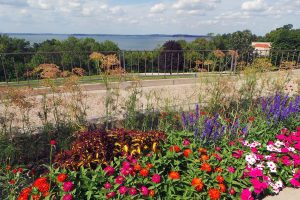 About a 20 minute walk from the Pyle Center, either along the leafy Lakeshore Path, or take the high road along Observatory Drive for a dramatic view over Lake Mendota (right). Driving is an option, but parking is a pain, so not recommended.
About a 20 minute walk from the Pyle Center, either along the leafy Lakeshore Path, or take the high road along Observatory Drive for a dramatic view over Lake Mendota (right). Driving is an option, but parking is a pain, so not recommended.
Website: https://allencentennialgarden.org/
Address: 620 Babcock Dr, Madison
Phone: 608-576-2501
Babcock Hall Dairy Store

Named after the UW researcher in the department of Agricultural Chemistry who invented the first reliable butterfat content milk test in 1890, the Plant and Dairy Store produces signature products for the university and community. Most know Babcock Hall for its award-winning ice cream that frequently is voted “Best of Madison” by Madison Magazine and is only sold on campus. This is small scale production: they crank out approximately 75,000 gallons of ice cream a year, but the plant also produces award-winning cheeses (Susan’s favorites are smoked cheddar and Dutch kase) and bottles locally produced milk, and they offer soup and sandwich specials during the week. Visit the second-story observation deck that overlooks the dairy plant to see ice cream and cheese being made. Read a feature story on Babcock ice cream in the 2012 issue of the College of Ag and Life Sciences Grow magazine to learn the history and how it’s made.
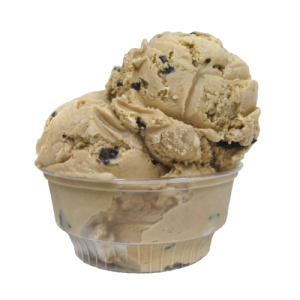 The Dairy Store rotates about 75 flavors of ice cream, changing its menu monthly and typically has 22 flavors on hand — with 11 standard flavors including Mocha Macchiato and Orange Custard Chocolate Chip — and a number of seasonal or super premium flavors, but if you don’t want to hike all the way over there (it’s a block away from Allen Centennial Gardens, so about a 20 minute walk), you can get a fix in the Memorial Union. Cones are so generous that a regular $3.50 (+ tax = $3.69; large is $5.15 + tax) in a sugar cone, wafer cone or dish is actually 2-3 scoops and you can mix and match flavors. And you can indulge guilt-free (sort of) because of the way the ice cream is made it has fewer calories than other brands: for a half-cup of vanilla: Häagen-Dazs: 270, Ben & Jerry’s: 200, Babcock Hall: 150.
The Dairy Store rotates about 75 flavors of ice cream, changing its menu monthly and typically has 22 flavors on hand — with 11 standard flavors including Mocha Macchiato and Orange Custard Chocolate Chip — and a number of seasonal or super premium flavors, but if you don’t want to hike all the way over there (it’s a block away from Allen Centennial Gardens, so about a 20 minute walk), you can get a fix in the Memorial Union. Cones are so generous that a regular $3.50 (+ tax = $3.69; large is $5.15 + tax) in a sugar cone, wafer cone or dish is actually 2-3 scoops and you can mix and match flavors. And you can indulge guilt-free (sort of) because of the way the ice cream is made it has fewer calories than other brands: for a half-cup of vanilla: Häagen-Dazs: 270, Ben & Jerry’s: 200, Babcock Hall: 150.
Website: https://babcockhalldairystore.wisc.edu/
Address: 1605 Linden Dr, Madison
Phone: 608-262-3045
DC Smith Greenhouse
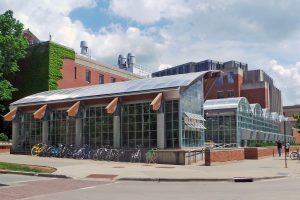 This greenhouse facility attached to the Horticulture Department on the UW-Madison campus, a block away from Allen Centennial Garden, is primarily a plant-growing space for the instructional needs of the departments and programs of the College of Agricultural and Life Sciences. The 10 growing bays are controlled by a state of the art computer system that allows users to program the environment to suit the needs of the plants. The 1,600 square foot conservatory is a relaxing space (especially nice in winter) with interiorscaping that emphasizes the ornamental function of plants while demonstrating the science of plant culture. The conservatory has won a major national award for design. The D.C. Smith Greenhouse is open to the public Monday – Friday 8:00am to 4:30pm. No parking nearby, so take the 20 minute walk from the Pyle Center (and combine the trip with a visit to Babcock Hall just down the street for ice cream and wander through Allen Centennial Gardens a block closer to the lake).
This greenhouse facility attached to the Horticulture Department on the UW-Madison campus, a block away from Allen Centennial Garden, is primarily a plant-growing space for the instructional needs of the departments and programs of the College of Agricultural and Life Sciences. The 10 growing bays are controlled by a state of the art computer system that allows users to program the environment to suit the needs of the plants. The 1,600 square foot conservatory is a relaxing space (especially nice in winter) with interiorscaping that emphasizes the ornamental function of plants while demonstrating the science of plant culture. The conservatory has won a major national award for design. The D.C. Smith Greenhouse is open to the public Monday – Friday 8:00am to 4:30pm. No parking nearby, so take the 20 minute walk from the Pyle Center (and combine the trip with a visit to Babcock Hall just down the street for ice cream and wander through Allen Centennial Gardens a block closer to the lake).
Website: https://dcsmithgreenhouse.cals.wisc.edu/
Address: 1575 Linden Dr., Madison
Phone: 608-262-3844
Botany Garden and Greenhouse
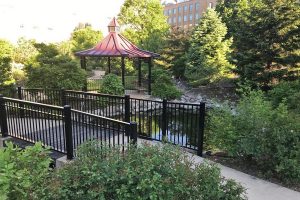 Eight greenhouse rooms with 8,000 square feet display more than 1,500 unique species of plants from the tropics, deserts, and bogs with collections of aquatics, succulents, bryophytes, ferns, orchids, herbs, and woody plants for a variety of educational purposes. The Botany Garden, just down the hill from Birge Hall where the Botany Department is housed (also reachable by University and Mills), showcases over 100 different plant families. It is open to the public from 8 am to 4 pm.
Eight greenhouse rooms with 8,000 square feet display more than 1,500 unique species of plants from the tropics, deserts, and bogs with collections of aquatics, succulents, bryophytes, ferns, orchids, herbs, and woody plants for a variety of educational purposes. The Botany Garden, just down the hill from Birge Hall where the Botany Department is housed (also reachable by University and Mills), showcases over 100 different plant families. It is open to the public from 8 am to 4 pm.
Website: https://livingcollection.botany.wisc.edu/
Address: Greenhouse: 430 Lincoln Dr. and Garden: 1090 University Ave., Madison
Phone: 608-262-1057
Picnic Point
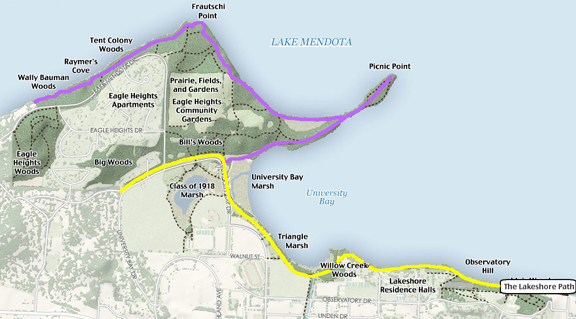 A nearly mile-long peninsula along Lake Mendota’s south shore in the Lakeshore Nature Preserve, its main priorities are to protect natural and cultural resources and to serve as an outdoor laboratory for teaching and research by UW-Madison students, faculty and staff. But visitors are welcome to walk the path out to the end of the point. From the Memorial Union, walk along the water’s edge on the Howard Temin Path portion of the Lakeshore Path (in yellow) to Willow Creek Woods, past Triangle Marsh and University Bay Marsh to get to the Lake Mendota Path (in purple) which intersects with the Temin Path at the main entrance to Picnic Point where it extends to the tip of Picnic Point. This is a favorite destination for birdwatchers for the opportunity to observe birdlife in the woods and fields of the Point and out across University Bay, as well as the 6-acre wetland, Picnic Point Marsh, along the north side of the Picnic Point peninsula (see a Preserve bird overview and bird checklist). Drivers can park in lots 129 or 130 near the beginning of the Lake Mendota Path, or bike the Lakeshore Path, then park your bike at the racks next to Lot 129 and walk out to the end of the Point.
A nearly mile-long peninsula along Lake Mendota’s south shore in the Lakeshore Nature Preserve, its main priorities are to protect natural and cultural resources and to serve as an outdoor laboratory for teaching and research by UW-Madison students, faculty and staff. But visitors are welcome to walk the path out to the end of the point. From the Memorial Union, walk along the water’s edge on the Howard Temin Path portion of the Lakeshore Path (in yellow) to Willow Creek Woods, past Triangle Marsh and University Bay Marsh to get to the Lake Mendota Path (in purple) which intersects with the Temin Path at the main entrance to Picnic Point where it extends to the tip of Picnic Point. This is a favorite destination for birdwatchers for the opportunity to observe birdlife in the woods and fields of the Point and out across University Bay, as well as the 6-acre wetland, Picnic Point Marsh, along the north side of the Picnic Point peninsula (see a Preserve bird overview and bird checklist). Drivers can park in lots 129 or 130 near the beginning of the Lake Mendota Path, or bike the Lakeshore Path, then park your bike at the racks next to Lot 129 and walk out to the end of the Point.
Website: https://lakeshorepreserve.wisc.edu/visit/places/picnic-point/
Address: 2000 University Bay Dr, Madison
Museums
Should you get tired of looking at plants, Madison is home to several museums within just a few minutes walk.
The UW Geology Museum, on the UW-Campus, has informative displays on how rocks, minerals, and fossils are formed. There is a surprisingly wide assortment of fossils from the Cambrian through the Tertiary, including some dinosaurs, in this small museum that only takes about an hour to see. Don’t miss the room of rocks that glow in UV light! Free, but donations are always accepted.
Website: http://geoscience.wisc.edu/museum/
Address: 1215 West Dayton Street, Madison
Phone: 608-262-2399
The Chazen Museum of Art is another UW museum on campus, with over 20,000 works of art in the collections representing the entire spectrum of art history across culture, period, media, and genre. There are paintings, watercolors and sculpture by European and American artists, photography exhibits, a collection of regionalist paintings by John Steuart Curry, glass art by René Lalique, Japanese woodblock prints, and much more.
Website: https://www.chazen.wisc.edu
Address: 750 University Ave, Madison
Phone: 608-263-2246
The Wisconsin Historical Museum on the Capital Square showcases the region’s history over the millennia in permanent and rotating exhibits. Operated by the Wisconsin Historical Society, each floor takes you through a different era of Wisconsin history from the indigenous peoples to modern times with artifacts, photographs, full-scale dioramas, audio-visual presentations, and interactive multimedia programs. You can stand in a replica of a 1,000-year-old house and visit a fur trade post, walk into a lead mine, climb up in a tractor cab, and pick up some quirky stuff in the gift shop. $5 donation.
Website: https://historicalmuseum.wisconsinhistory.org/
Address: 30 N. Carroll Street, Madison
Phone: 608-264-6555
The Wisconsin Veterans Museum, also on the Capitol Square, showcases the history of the many citizens who participated in military struggles from the Civil War to the Gulf War. The military history buff could spend several hours here checking out the displays that include a great deal of military paraphernalia — including tanks and aircraft — with much of it presented in informative life-sized and highly realistic dioramas (but the average person will get through it all in less than an hour). Free.
Website: https://www.wisvetsmuseum.com/
Address: 30 West Mifflin Street, Madison
Phone: 608-267-1799
The Madison Museum of Contemporary Art is housed at the Overture Center for the Arts that was designed by world-renowned architect Cesar Pelli and boasts over 50,000 square feet of exhibition space and a beautiful rooftop sculpture garden. The museum’s collection spans the 20th and 21st centuries and includes works by Frida Kahlo, John Steuart Curry, and Diego Rivera. The main galleries of the museum host major exhibitions, while the sculpture garden features rotating exhibits in a stunning garden setting.
Website: https://www.mmoca.org/
Address: 227 State Street, Madison, WI
Phone: 608-257-0158
Madison Children’s Museum
One-of-a-kind interactive exhibits, daily activities, and year-round special events cater to kids through age 12. Check out the greenhouse, chickens, and other animals on the rooftop, travel back into Wisconsin history in an authentic 1838 log cabin, run in the giant gerbil wheel that turns energy into light, splash in the water play station, and much more.
Website: http://madisonchildrensmuseum.org/
Address: 2116 100 N Hamilton St, Madison
Phone: 608-256-6445
Monona Terrace
 Two blocks from the Wisconsin State Capitol building, is the Frank Lloyd Wright-inspired convention center on Lake Monona. [The famed architect was born in Wisconsin and designed many of Madison’s most notable buildings, including the headquarters of the First Unitarian Society and several private houses. For fans of the architect, Taliesin East, just outside Spring Green is a must (see Day Trips, below).] It only took 59 years after Wright originally proposed a design in 1938 for the Convention Center to be built. This visually stunning building includes his original curved glass façade, but the interior was designed by former Wright apprentice Anthony Puttnam of Taliesin Associated Architects. The rooftop terrace offers nice downtown views and panoramic vistas of Lake Monona. The facility hosts over 600 conventions, meetings and weddings each year, as well as free community programs, daily tours (1pm, $5), and has a rooftop cafe. About a 10-minute drive (paid parking is available in the parking ramp that is part of the convention center) or 25 minute walk from the Pyle Center.
Two blocks from the Wisconsin State Capitol building, is the Frank Lloyd Wright-inspired convention center on Lake Monona. [The famed architect was born in Wisconsin and designed many of Madison’s most notable buildings, including the headquarters of the First Unitarian Society and several private houses. For fans of the architect, Taliesin East, just outside Spring Green is a must (see Day Trips, below).] It only took 59 years after Wright originally proposed a design in 1938 for the Convention Center to be built. This visually stunning building includes his original curved glass façade, but the interior was designed by former Wright apprentice Anthony Puttnam of Taliesin Associated Architects. The rooftop terrace offers nice downtown views and panoramic vistas of Lake Monona. The facility hosts over 600 conventions, meetings and weddings each year, as well as free community programs, daily tours (1pm, $5), and has a rooftop cafe. About a 10-minute drive (paid parking is available in the parking ramp that is part of the convention center) or 25 minute walk from the Pyle Center.
Website: https://www.mononaterrace.com/
Address: 1 John Nolen Dr, Madison
Phone: 608-261-4000
Henry Vilas Zoo
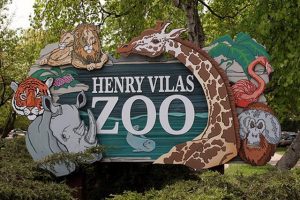 This small (28 acre) free public zoo located in Vilas Park houses amphibians, birds, fish, insects, mammals, and reptiles from around the world. One of only a handful of admission-free, community-supported zoos in the country, yet fully accredited by the Association of Zoos and Aquariums, it offers a number of indoor and outdoor exhibits, most in naturalistic settings, including a Tropical Rainforest Aviary, Big Cats, North American Prairie, Arctic Passage, Wisconsin Heritage (with 3 badgers and a rescued sandhill crane), and more. A 10-minute drive or half hour walk from the Pyle Center.
This small (28 acre) free public zoo located in Vilas Park houses amphibians, birds, fish, insects, mammals, and reptiles from around the world. One of only a handful of admission-free, community-supported zoos in the country, yet fully accredited by the Association of Zoos and Aquariums, it offers a number of indoor and outdoor exhibits, most in naturalistic settings, including a Tropical Rainforest Aviary, Big Cats, North American Prairie, Arctic Passage, Wisconsin Heritage (with 3 badgers and a rescued sandhill crane), and more. A 10-minute drive or half hour walk from the Pyle Center.
Website: http://www.vilaszoo.org/
Address: 702 South Randall Ave, Madison
Phone: 608-266-4732
In Madison
Olbrich Botanical Gardens
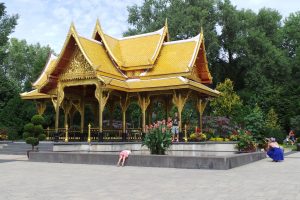
Thai pavilion at Olbrich Botanical Gardens
This is one of the best small municipal botanic gardens in the country, with 16 acres jam packed with fantastic display gardens including the only authentic Thai Pavilion and Garden in the continental United States and an indoor tropical conservatory. Best appreciated in the winter, but still nice in summer, the 50-foot-high, 10,000-square-foot glass pyramid houses a diverse collection of over 650 tropical plants, free-flying birds and butterflies, and a rushing waterfall.

Rose Garden and tower at Olbrich Botanical Gardens
Outdoors enjoy over 20 gardens including a formal English-style Sunken Garden, Meadow Garden, Shade Garden, Rock Garden and many more. Be sure to walk up to the top of the 30-foot Prairie-style rustic tower built from regional stone overlooking the fountains of the beautifully manicured rose garden with the namesake plants intermingling with other perennials. And best of all – it’s FREE admission to the outdoor gardens ($7 for the conservatory during Blooming Butterflies July 19-August 12).
Olbrich Gardens is about 5½ miles east of the conference site; a ridesharing service or your own vehicle is the most practical way to get there, although buses do run there. Or rent a bike for a pleasant 25 minute ride.
Website: http://www.olbrich.org/
Address: 3330 Atwood Avenue, Madison, Wisconsin
Phone: 608-246-4550
University of Wisconsin-Madison Arboretum
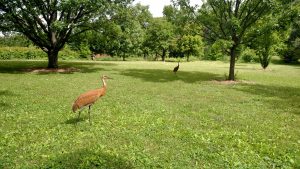
Sandhill cranes in Longenecker Gardens at UW-Madison Arboretum
Managed by the UW, the Arboretum is home to the oldest and most varied collection of restored ecological communities in the world, including tallgrass prairies, native oak and maple woodlands, as well as the 35-acre Longenecker Horticultural Gardens with more than 5,000 woody plants including major collections of lilacs, crabapples, viburnums and conifers and the 4-acre Wisconsin Native Plant Garden demonstrating how these plants can be used in home landscaping. Look for the wild turkeys and sandhill cranes that roam the extensive grounds! About 4 miles from the Pyle Center to the Visitor Center, so car or bike is the best bet. If you want to walk on any of the nearly 20 miles of trails (bikes are only allowed on paved roads), and especially in the woods, be sure to bring insect repellent.
You can learn about the history of the Arboretum in this special Isthmus issue.
Website: https://arboretum.wisc.edu/
Address: 1207 Seminole Highway, Madison, Wisconsin
Phone: 608-263-7888
Troy Gardens
On the north side of town, this 15 acre site includes nearly 4 acres of community gardens, a 5-acre fenced (for deer) diversified organic CSA vegetable farm, kid’s gardening program, natural areas, and more. Nearly 10 acres have been transformed from a formerly weedy urban lot into a thriving native tallgrass praire. Take a self-guided tour of the land any time using the Sol Levin Memorial Trail guide (start at #1, on page 2).
About 7 miles from campus, a 20-25 minute drive depending on the route and traffic.
Website: http://www.communitygroundworks.org/what-we-do/troy-community-gardens
Address: 500 Block of Troy Drive, Madison
Phone:
Willy Street
Williamson Street, affectionately known as Willy Street, is a diverse Near East Side community on a single street east of the Capital Square. This is one of two of Madison’s most quintessential walkable neighborhoods. You’ll have a good shot at spotting a bonafide hippie here among the eclectic mix of locally owned shops, restaurants, and entertainment establishments that line the street. The annual groovy Willy Street Fair in September brings the community together as a major neighborhood event and fundraiser.
Monroe Street
The other walkable Madison neighborhood, Monroe Street is over a mile of locally-owned specialty shops and businesses, surrounded by a historic neighborhood. This trendy corridor just past Camp Randall and the UW-Madison football stadium features Edgewood College, Wingra Park, and more than 20 restaurants and coffee shops. Orange Tree Imports and Katy’s American Indian Arts have been there for decades, joined by numerous other businesses including Art Gecko, Calabash Gifts, Infusion Chocolates, Madison Chocolate Company, Strictly Discs, and several boutique clothing and accessories stores.
Website: http://www.monroestreetmadison.com/
Get Out on the Lakes
 If you’re looking to enjoy some time on the lakes, three local business offer boat rentals. The closest to the Pyle Center, Brittingham Boats (1.3 miles, a 25 minute walk), offers premium paddle craft rentals including stand up paddle boards, single and tandem kayaks, and canoes.
If you’re looking to enjoy some time on the lakes, three local business offer boat rentals. The closest to the Pyle Center, Brittingham Boats (1.3 miles, a 25 minute walk), offers premium paddle craft rentals including stand up paddle boards, single and tandem kayaks, and canoes.
Website: https://www.madisonboats.com/
Address: 701 W. Brittingham Place, Madison
Phone: 608-250-2555
 If paddling isn’t your style and you want to see Madison from a different perspective, Betty Lou Cruises offers daily public cruises from Mariner’s Inn on Lake Mendota (5339 Lighthouse Bay Dr.) and at the Machinery Row building on Lake Monona (601 Williamson St.). Costs vary depending on the length and type of tour. Check the weather forecast before purchasing tickets — tours often go even in the rain and it can be hot and overcrowded indoors with everyone crammed inside and windows closed — but it is glorious out on the deck when the weather is nice! Reviews of the food vary widely (I’ve never gone on a cruise that included food).
If paddling isn’t your style and you want to see Madison from a different perspective, Betty Lou Cruises offers daily public cruises from Mariner’s Inn on Lake Mendota (5339 Lighthouse Bay Dr.) and at the Machinery Row building on Lake Monona (601 Williamson St.). Costs vary depending on the length and type of tour. Check the weather forecast before purchasing tickets — tours often go even in the rain and it can be hot and overcrowded indoors with everyone crammed inside and windows closed — but it is glorious out on the deck when the weather is nice! Reviews of the food vary widely (I’ve never gone on a cruise that included food).
Website: http://www.bettyloucruises.com/
Phone: 608-246-3138
Short Road Trips (within 60 miles)
Baraboo
50 miles northwest of Madison
As you head northwest out of Madison the rolling hills suddenly become steeper as you hit the Baraboo Range. The Baraboo Hills are all that remain of one of the most ancient rock outcrops in North America, and are an ecologically unique part of the Midwest. The eastern end of the Baraboo Range was glaciated during the most recent glaciation, while the western half was not, marking the eastern boundary of Wisconsin’s Driftless Area. There are many wonderful natural areas in this area, as well as other attractions.
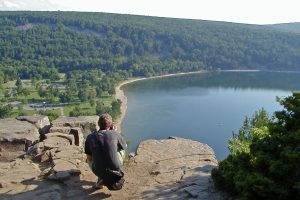 Devil’s Lake State Park is over 9,000 acres of spectacular scenery surrounding chilly Devil’s Lake (a mis-interpretation of the native Ho-Chunk name which better translates to “Sacred Lake” or “Spirit Lake”), a remnant of a gorge of the Wisconsin River prior to the last ice age stuck between two moraines. It is best known for the 500-foot-high quartzite bluffs backing the lake. Over 29 miles of hiking trails for any skill level take you through shady woodlands, across rock talus slopes, or on amazingly scenic sections of the National Ice Age Trail.
Devil’s Lake State Park is over 9,000 acres of spectacular scenery surrounding chilly Devil’s Lake (a mis-interpretation of the native Ho-Chunk name which better translates to “Sacred Lake” or “Spirit Lake”), a remnant of a gorge of the Wisconsin River prior to the last ice age stuck between two moraines. It is best known for the 500-foot-high quartzite bluffs backing the lake. Over 29 miles of hiking trails for any skill level take you through shady woodlands, across rock talus slopes, or on amazingly scenic sections of the National Ice Age Trail.
Website: https://dnr.wi.gov/topic/parks/name/devilslake/
Parfrey’s Glen, Wisconsin’s first state natural area, is located just east of the park. Unfortunately heavy rainstorms and flooding in 2008 washed away nearly all vegetation in the glen (and the mosses and ferns that used to cover the exposed sandstone walls have not grown back yet) and damage to some areas has not been repaired. But the currently maintained trail offers a relatively easy walk through the woods and into a gorge (which requires crossing a shallow stream, so waterproof shoes are recommended) where the cool and shaded climate results in a flora more typical of northern Wisconsin with several rare plant species and two state-threatened birds.
Website: https://dnr.wi.gov/topic/Lands/naturalareas/index.asp?SNA=1
International Crane Foundation
 This is the headquarters of the non-profit conservation organization that works worldwide and in the US with local partners to raise and conserve cranes. This is the only place on Earth where you can see all 15 of the world’s crane species live in one place. The 250-acre property includes live crane exhibits, a visitor center, breeding facilities, a research library and nature trails. You’re likely to see sandhill cranes in the wild on the way from Madison to Baraboo, but at ICF the stars are the other native crane, and the largest and rarest in North America, whooping cranes. Check them out in their naturalistic enclosure from a great viewing pavilion. [If you want to see wild whooping cranes, your best bet is to head an hour further north to the Necedah Wildlife Refuge.]
This is the headquarters of the non-profit conservation organization that works worldwide and in the US with local partners to raise and conserve cranes. This is the only place on Earth where you can see all 15 of the world’s crane species live in one place. The 250-acre property includes live crane exhibits, a visitor center, breeding facilities, a research library and nature trails. You’re likely to see sandhill cranes in the wild on the way from Madison to Baraboo, but at ICF the stars are the other native crane, and the largest and rarest in North America, whooping cranes. Check them out in their naturalistic enclosure from a great viewing pavilion. [If you want to see wild whooping cranes, your best bet is to head an hour further north to the Necedah Wildlife Refuge.]
Website: https://www.savingcranes.org/
Address: 9445 E11376 Shady Lane Rd, Baraboo, WI
Phone: 608-356-9462
Aldo Leopold Foundation
Aldo Leopold was considered by many to be the father of wildlife ecology and a premier conservationist of the 20th century. The “green”-designed Leopold Center features exhibits of his life and legacy amid the landscape that inspired his most famous work, A Sand County Almanac. Outside there are hikes through the prairies and woods or take the guided tour that goes inside the historic Shack.
Website: http://aldoleopoldnaturecenter.org/
Address: E13701 Levee Road, Baraboo, WI
Phone: 608-355-0279
Mid-Continent Railway Museum
For anyone into trains, this is the place to go. The collection emphasizes the preservation of railroad items operated in the upper Midwest from the period of 1880-1916, with 13 steam and 7 diesel locomotives and several outbuildings. Depart from an historic wooden depot, built in 1894, to take a seven-mile, 55-minute round-trip train ride in restored steel coaches built a century ago on a former branch line of the Chicago & North Western Railway nestled in a valley between the Baraboo Hills. Or just walk the grounds for free — and check out the historic restoration gardens maintained by the Sauk Co. Master Gardeners!
Website: https://www.midcontinent.org/
Address: E8948, Museum Road, North Freedom, WI
Phone: 608-522-4261
Blue Mounds
about 20 miles west of Madison
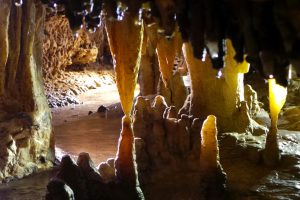 About 20 miles (40 minutes) west of Madison amid the rolling farmland is a geologic wonder and National Natural Landmark accidentally discovered in 1939 when limestone quarry workers blasted a section to expose an opening to a cave. Work at the quarry was immediately stopped and Cave of the Mounds opened a year later once boardwalks and lighting were installed. Many special formations are found inside the cave in addition to the usual stalactites and stalagmites.
About 20 miles (40 minutes) west of Madison amid the rolling farmland is a geologic wonder and National Natural Landmark accidentally discovered in 1939 when limestone quarry workers blasted a section to expose an opening to a cave. Work at the quarry was immediately stopped and Cave of the Mounds opened a year later once boardwalks and lighting were installed. Many special formations are found inside the cave in addition to the usual stalactites and stalagmites.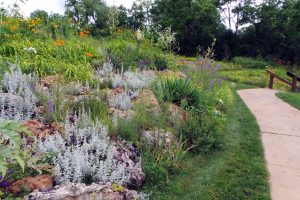 The Chicago Academy of Sciences considers it to be “the significant cave of the upper Midwest” because of its beauty. With a year round temperature of 50 degrees, this is the perfect place to visit on a hot summer day! In addition to the hour long tour that includes lots of stories and information, walk the trails through prairie and woodland and check out the many gardens: prairie and savanna restoration gardens, rock and rain gardens, and the butterfly garden.
The Chicago Academy of Sciences considers it to be “the significant cave of the upper Midwest” because of its beauty. With a year round temperature of 50 degrees, this is the perfect place to visit on a hot summer day! In addition to the hour long tour that includes lots of stories and information, walk the trails through prairie and woodland and check out the many gardens: prairie and savanna restoration gardens, rock and rain gardens, and the butterfly garden.
Website: https://www.caveofthemounds.com/
Address: 2975 Cave of the Mounds Rd, Blue Mounds, WI
Phone: 608-437-3038
Not far away is Blue Mounds State Park, home to the highest hills in Southern Wisconsin (which isn’t saying much, really, at only 1,719 feet elevation and 934 feet above the surrounding land). Popular with hikers, mountain bikers, and campers, there is also an informative Nature Center providing insights into the flora, fauna, and geology of the area.
Website: Blue Mound State Park
Address: 4350 Mounds Park Rd, Blue Mounds, WI
Phone: 608-437-5711
Janesville
40 miles south of Madison (about 45 minute drive if traffic/construction isn’t too bad)
 It’s well worth making the effort to drive down from Madison, but if you’re driving to the conference from the south, you MUST take the time for a quick detour off I-39 S/I-90 E at exit 175-A to visit Rotary Botanical Gardens, a magnificent, award winning botanic garden created from a former gravel and sand pit. This 20-acre site has 24 different garden areas including Japanese, Scottish, French formal, Italian, and English cottage gardens.
It’s well worth making the effort to drive down from Madison, but if you’re driving to the conference from the south, you MUST take the time for a quick detour off I-39 S/I-90 E at exit 175-A to visit Rotary Botanical Gardens, a magnificent, award winning botanic garden created from a former gravel and sand pit. This 20-acre site has 24 different garden areas including Japanese, Scottish, French formal, Italian, and English cottage gardens. 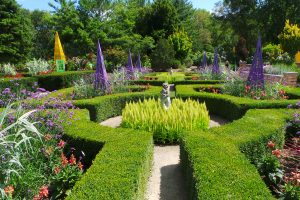 Director of Horticulture Mark Dwyer creates magical spaces with creative designs and plant combinations, especially in the beds around the parking lot and Visitor Center that change annually. This year the theme for the Entrance and Terrace Gardens is a “Pastel Extravaganza” with color combinations featuring salmon, pink, powder blue and white, while the Reception Garden will become a white garden, featuring hints of blue. Enter a make-believe, underwater display when you walk through the Giant Aquarium, a fun structure with blue sides and planted with live plants in a sandy “sea floor” as well as hanging fish and other aquatic creatures. The Demonstration Beds this year will be filled with a wide range of seed grown New Guinea impatiens selections while the Nancy Yahr Memorial Children’s Garden will be a fantastic A-Z Pollinator Garden featuring over 100 colorful varieties of plants for pollinators. The 13 parallel beds that have often held edible plants will display flowers, vegetables and herbs from a specific country this year.
Director of Horticulture Mark Dwyer creates magical spaces with creative designs and plant combinations, especially in the beds around the parking lot and Visitor Center that change annually. This year the theme for the Entrance and Terrace Gardens is a “Pastel Extravaganza” with color combinations featuring salmon, pink, powder blue and white, while the Reception Garden will become a white garden, featuring hints of blue. Enter a make-believe, underwater display when you walk through the Giant Aquarium, a fun structure with blue sides and planted with live plants in a sandy “sea floor” as well as hanging fish and other aquatic creatures. The Demonstration Beds this year will be filled with a wide range of seed grown New Guinea impatiens selections while the Nancy Yahr Memorial Children’s Garden will be a fantastic A-Z Pollinator Garden featuring over 100 colorful varieties of plants for pollinators. The 13 parallel beds that have often held edible plants will display flowers, vegetables and herbs from a specific country this year.
Take a slightly outdated (2008) virtual tour at https://mastergardener.extension.wisc.edu/article/rotary-botanical-gardens/. Bring your membership card from a participating American Horticulture Society Reciprocal Admissions Program to get in for free ($7 adults).
Website: http://www.rotarybotanicalgardens.org/
Address: 1455 Palmer Dr, Janesville
phone: 608-752-3885
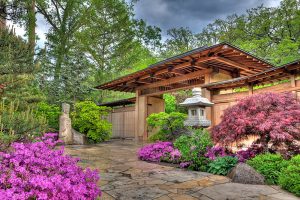 And if you are driving up from the south, another worthwhile stop not far away is Anderson Japanese Garden, just south of the border in Rockford, Illinois. This is one of the highest ranked public Japanese Gardens in North America (consistently #1 or #2, always competing with the Japanese Gardens in Portland, Oregon for top honors). The 12-acre authentic gardens are a 13th-century “pond strolling” garden with several waterfalls and ponds, streams, rock formations, winding paths, and a sukiya style tea house and guest house. The “Garden of Reflection” is a contemporary Japanese-inspired garden, with bronze angel sculptures by Carl Milles. Lovely surprises await visitors around every twist of the garden paths and through small gaps in wooded landscapes. Plantings include Japanese maples, cloud pines, azaleas, magnolias, and rhododendrons.
And if you are driving up from the south, another worthwhile stop not far away is Anderson Japanese Garden, just south of the border in Rockford, Illinois. This is one of the highest ranked public Japanese Gardens in North America (consistently #1 or #2, always competing with the Japanese Gardens in Portland, Oregon for top honors). The 12-acre authentic gardens are a 13th-century “pond strolling” garden with several waterfalls and ponds, streams, rock formations, winding paths, and a sukiya style tea house and guest house. The “Garden of Reflection” is a contemporary Japanese-inspired garden, with bronze angel sculptures by Carl Milles. Lovely surprises await visitors around every twist of the garden paths and through small gaps in wooded landscapes. Plantings include Japanese maples, cloud pines, azaleas, magnolias, and rhododendrons.
Website: https://andersongardens.org/
Address: 318 Spring Creek Rd, Rockford, IL
Phone: 815-229-9390
Prairie du Sac
25-30 miles from Madison, depending on route taken
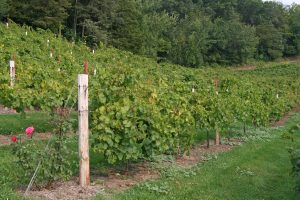 Most people don’t expect an award-winning winery in the hinterlands of Wisconsin, but here it is, Wollersheim Winery & Distillery, located on a scenic hillside overlooking the Wisconsin River, about 45 minutes from Madison on the way up to Baraboo. Actually planted in the 1840’s, the property was resurrected in the 1970’s and with the arrival of winemaker Phillipe Coquard from France, has been producing award-winning wines ever since. Their Dry Riesling received Best White Wine at the 2018 Pacific Rim International Wine Competition held in San Bernardino, California! My favorite is the light, crisp white Prairie Fumé™, perfect for sipping on a hot summer day. The newer distillery (state law changed in 2009, allowing wineries to start distilling again) makes several brandies, gin, and absinthe. Take a tour, enjoy a wine or spirits tasting, enjoy a drink on the terrace or bring (or buy) food for a picnic.
Most people don’t expect an award-winning winery in the hinterlands of Wisconsin, but here it is, Wollersheim Winery & Distillery, located on a scenic hillside overlooking the Wisconsin River, about 45 minutes from Madison on the way up to Baraboo. Actually planted in the 1840’s, the property was resurrected in the 1970’s and with the arrival of winemaker Phillipe Coquard from France, has been producing award-winning wines ever since. Their Dry Riesling received Best White Wine at the 2018 Pacific Rim International Wine Competition held in San Bernardino, California! My favorite is the light, crisp white Prairie Fumé™, perfect for sipping on a hot summer day. The newer distillery (state law changed in 2009, allowing wineries to start distilling again) makes several brandies, gin, and absinthe. Take a tour, enjoy a wine or spirits tasting, enjoy a drink on the terrace or bring (or buy) food for a picnic.
Website: http://www.wollersheim.com/
Address: 7876 Wisconsin 188, Sauk City, WI
Phone: 608-643-6515
Spring Green
35 miles west of Madison (about 1 hour scenic drive)
 This is where famed architect Frank Lloyd Wright spent his childhood and returned when he was at the height of his international fame. Taliesin was his home, studio and school that sports designs from almost every decade of his long life. A variety of tours designed for every level of interest (but require a significant amount of standing, stair climbing and walking on uneven terrain) are a great way to learn more about the Taliesin property and Frank Lloyd Wright himself. For Frank Lloyd Wright fanatics, use the Frank Lloyd Wright Trail app, complete with an interactive map and trip planner tool, to get you started on a self-guided tour. If you’re really into his architecture, the Chicago area has more Wright buildings than anywhere else in the world.
This is where famed architect Frank Lloyd Wright spent his childhood and returned when he was at the height of his international fame. Taliesin was his home, studio and school that sports designs from almost every decade of his long life. A variety of tours designed for every level of interest (but require a significant amount of standing, stair climbing and walking on uneven terrain) are a great way to learn more about the Taliesin property and Frank Lloyd Wright himself. For Frank Lloyd Wright fanatics, use the Frank Lloyd Wright Trail app, complete with an interactive map and trip planner tool, to get you started on a self-guided tour. If you’re really into his architecture, the Chicago area has more Wright buildings than anywhere else in the world.
Website: https://www.taliesinpreservation.org/
Address: 5607 County Road C, Spring Green, WI 53588
Phone (for tour info): (608) 588-7900
Just a few miles away on a very scenic road is the Frank Lloyd Wright-inspired House on the Rock, an incredible (bizzare?) tourist attraction featuring a very unusual house, the world’s largest carousel, automated music machines and numerous other eclectic collections. Perched high atop an outcropping of Deer Shelter Rock, this sprawling house — a testament to one man’s desire to follow in the footsteps of Frank Lloyd Wright (whether he succeeded depends upon one’s tastes) — integrated into the rock contains more than 3,200 windows and 218-foot-long Infinity Room that projects over a cliff like a knife. Some of the displays, such as the “The Streets of Yesterday” and are “The Music of Yesterday” combining real antiques and replicas are interesting, but other crazy and random collections leave you scratching your head.  The carousel featuring 269 carousel animals — none of them horses, 182 chandeliers, and over 20,000 lights is truly impressive. Lots of walking up and down, it smells like a musty basement and there’s no AC, yet many people rate it a “must stop and see once in your life” place because it’s “so odd and interesting you just have to experience it” while others can’t decide if it was a waste of time and money or glad they saw it! This place was showcased on America Pickers so it may appeal to fans of that TV show. Plan to spend at least 3 hours to see all three sections.
The carousel featuring 269 carousel animals — none of them horses, 182 chandeliers, and over 20,000 lights is truly impressive. Lots of walking up and down, it smells like a musty basement and there’s no AC, yet many people rate it a “must stop and see once in your life” place because it’s “so odd and interesting you just have to experience it” while others can’t decide if it was a waste of time and money or glad they saw it! This place was showcased on America Pickers so it may appeal to fans of that TV show. Plan to spend at least 3 hours to see all three sections.
Website: https://www.thehouseontherock.com/HOTR_AttractionMain.htm
Address: 5754 State Road 23, Spring Green
Phone: 608-935-3639
 If you can get tickets, American Players Theater is a fun place to experience professional outdoor classical theater. Just just off the Wisconsin River across Wisconsin Highway 23 from Taliesin, this 110 acre site includes a 1,089-seat outdoor amphitheater. The plays at “the hill theatre” are typically Shakespeares, with some 20th-century productions performed in the 200-seat indoor Touchstone Theatre. Bring a portable meal to enjoy in the picnic area before a performance, or pre-order a catered meal or get sandwiches and beverages from the concession stand.
If you can get tickets, American Players Theater is a fun place to experience professional outdoor classical theater. Just just off the Wisconsin River across Wisconsin Highway 23 from Taliesin, this 110 acre site includes a 1,089-seat outdoor amphitheater. The plays at “the hill theatre” are typically Shakespeares, with some 20th-century productions performed in the 200-seat indoor Touchstone Theatre. Bring a portable meal to enjoy in the picnic area before a performance, or pre-order a catered meal or get sandwiches and beverages from the concession stand.
Website: https://americanplayers.org/
Address: 5950 Golf Course Rd, Spring Green
Phone: 608-588-2361
Wisconsin Dells
About 55 miles north of Madison
If you’re bringing kids, the waterparks are THE place to go (The Dells are known as the “Waterpark Capital of the World”). The Big 5 Dells resorts with large indoor waterparks are the Mt. Olympus Water & Theme Park, Wilderness Territory, Kalahari Resort, Chula Vista Resort, and Great Wolf Lodge. We’ve had a couple of Extension and Master Gardener conferences at two of these, and while the facilities at both were very nice, I’ve never used the waterpark portions, so can’t comment on that part!
 But the natural scenic beauty of the Wisconsin River as it traverses a path cut by ancient glaciers is well worth a visit even if you’re not into the rest of it (mega resorts, fudge shops, cheap t-shirts, tacky tourist shops and more along the Strip = Wisconsin Dells Parkway). You can hike in the nature preserve along the banks of the Upper Dells at the mouth of The Narrows or take a boat trip to see the Dells Of The Wisconsin River State Natural Area. A power dam separates the River into the Upper and Lower Dells, with different boat or amphibious vehicle (“Ducks”) trips touring the scenic parts of both (2 hours on Upper including landings at Witches Gulch, 1 hour long on Lower) while providing a history of the area. At end of the last Ice Age, an ice dam holding back the waters of a melted glacier suddenly gave way and over just a few days carved a 15-mile gorge lined with serpentine canyons and odd outcroppings. The river corridor has numerous cliffs, tributary canyons, and rock formations carved into Cambrian sandstone.
But the natural scenic beauty of the Wisconsin River as it traverses a path cut by ancient glaciers is well worth a visit even if you’re not into the rest of it (mega resorts, fudge shops, cheap t-shirts, tacky tourist shops and more along the Strip = Wisconsin Dells Parkway). You can hike in the nature preserve along the banks of the Upper Dells at the mouth of The Narrows or take a boat trip to see the Dells Of The Wisconsin River State Natural Area. A power dam separates the River into the Upper and Lower Dells, with different boat or amphibious vehicle (“Ducks”) trips touring the scenic parts of both (2 hours on Upper including landings at Witches Gulch, 1 hour long on Lower) while providing a history of the area. At end of the last Ice Age, an ice dam holding back the waters of a melted glacier suddenly gave way and over just a few days carved a 15-mile gorge lined with serpentine canyons and odd outcroppings. The river corridor has numerous cliffs, tributary canyons, and rock formations carved into Cambrian sandstone.
Websites:
https://www.dells.com/
https://www.wisdells.com/wisconsin-dells.htm
Dells Boat Tours: In summer, boats leave every 20 or 30 minutes between 9:30 a.m. and 7 p.m. Upper Dells rides are two hours and Lower Dells trips one hour.



